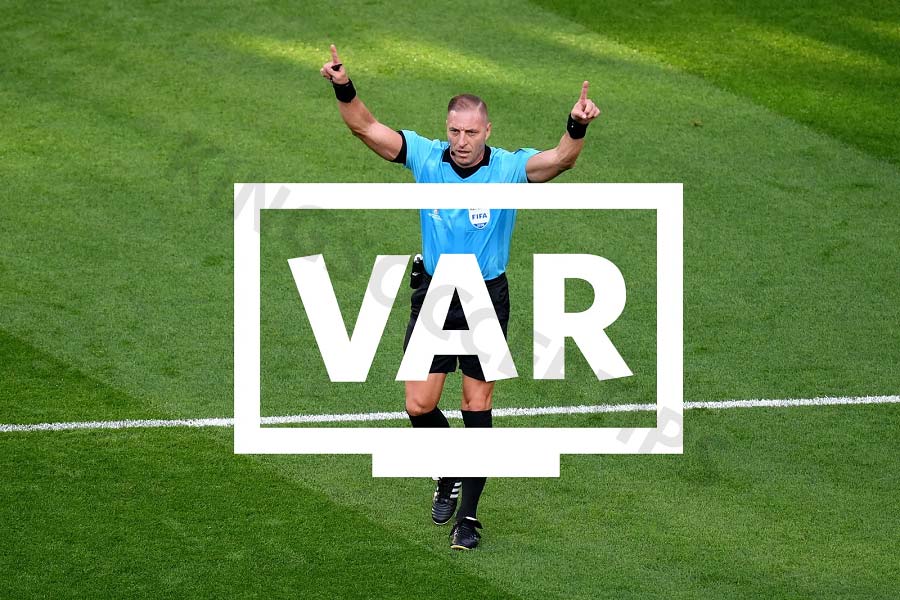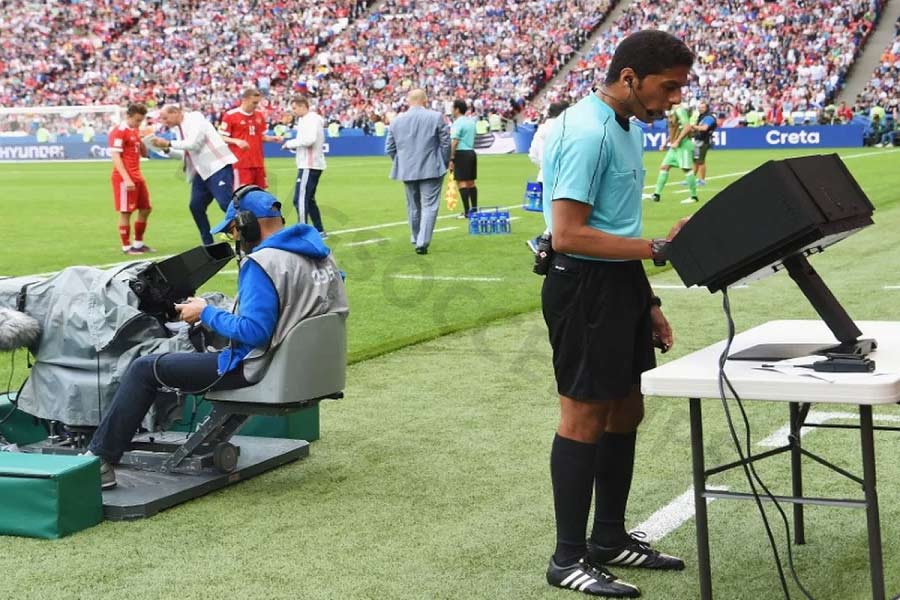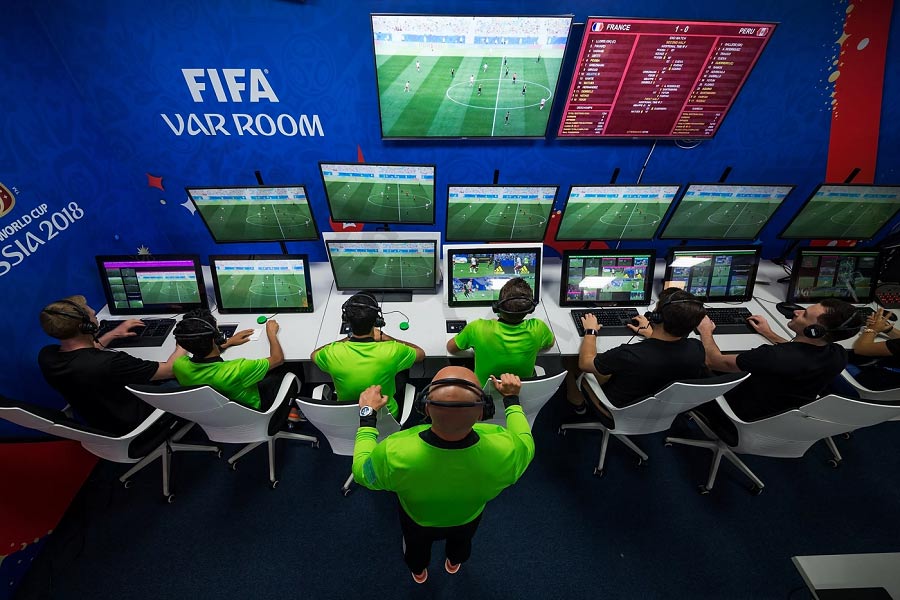What is var in football? In what cases is VAR usually used?
When watching football, especially during the World Cup, you often hear about VAR technology being mentioned when controversial situations occur on the field. However, this is still a fairly new concept for those who rarely follow football. Don’t worry, Kingsoccertips will provide full information to answer questions like: what is VAR in football? When and where is this technology applied? We will explore it all in this article of Kingsoccertips.

What is VAR in football?
What does VAR in football mean? It is Video Assistant Referee, which is not simply using video to assist the referee. This is an important tool that has become popular in major football tournaments, helping referees have a panoramic view of the match and make accurate decisions, limiting controversy.
The number of cameras in the VAR system varies depending on the infrastructure of each tournament. The minimum requirement is 33 cameras, including 4 Ultra Slow Motion cameras with a speed of 120 frames per second and 8 Super Slow Motion cameras. Other cameras must have Ultra HD resolution to provide the most detailed images possible. All 33 cameras operate continuously, covering all angles, especially controversial areas such as the goal and the touchline, which are observed by specialized cameras.
VAR technology is not only innovative in football, but also an advanced approach that helps referees analyze each situation in detail. Videos from VAR provide the ability to evaluate every situation in detail, helping referees make the fairest decisions.
When was VAR technology born?
After learning about what does var mean in football, let’s refer to more information about when was VAR born? VAR has become an indispensable part of important matches, bringing fairness to football. After the question of what is VAR technology, the next question is where is the origin of this technology and when did VAR appear? Here is the information we will provide you:
VAR was approved by IFAB (International Football Association Board) – the organization that manages international football laws, in 2016 and was first used in a professional football tournament in the US in August of the same year.
The most brilliant appearance of VAR technology was probably at the 2018 World Cup, when FIFA (Fédération Internationale de Football Association) approved its use. However, during the tournament, there were still controversies, especially in the matches between the French and Australian teams. However, VAR proved its influence through intervention and contribution in many important situations in this tournament.
Learn more about football prediction for today to get more accurate information and bets.
When is VAR technology commonly used?
VAR technology does not operate automatically but only intervenes in specific situations according to FIFA’s decisions. Situations such as determining errors when scoring goals, exchanging direct penalties (11m) or determining errors that deserve a direct red card are cases where VAR intervenes to support the referee on the field. This helps to increase the fairness and transparency of the referee’s decisions.

When there is a dispute about a goal
VAR technology plays an important role in controversial goal scoring situations from the opposing team. It helps the referee review the entire process leading to the goal. Small errors such as offside or handball – things that cannot be clearly seen from the referee’s perspective on the field – are recorded by the VAR camera and transmitted to the referee. The referee will then carefully consider each situation, evaluate and make the most accurate decision to ensure fairness and transparency for the match.
Penalties
VAR technology often intervenes the most in determining penalties in football matches. Referees often use VAR in such sensitive situations to make the most accurate decision. The goal is to limit conflicts and arguments between players and fans from both teams, creating conditions for a fairer and more transparent match.
Direct red card errors
Violent behavior in football causes serious consequences, not only affecting the health and psychology of players but also making the audience feel angry. That is the reason why VAR technology was developed, to minimize the worst situations and make fair decisions.
In addition to handling controversial situations, VAR technology also clearly regulates intervention in direct red card situations. VAR only intervenes when the referee decides to directly issue a red card, while second yellow card situations will not be supported by this modern technology. It helps focus on the most urgent situations to ensure fairness and transparency in the referee’s decision.
Inaccurate judgments of referees
In fact, referees often receive anger because of incorrect decisions on the football field. That is why VAR is applied to minimize those mistakes, allowing referees the opportunity to correct and adjust decisions to make the match fairer.
Although VAR brings many advantages, it also receives a lot of criticism. Matches supported by VAR are often fairer, but some people think it takes away the emotion of football. Moreover, the referee has to spend time on the sidelines to watch videos from VAR, prolonging the match and losing its appeal. On the other hand, the acceptance of VAR technology is gradually increasing, some people believe that this is a step forward to increase fairness in matches.
Will VAR be used in the 2022 World Cup?
Although VAR has received a lot of criticism, its role in the 2018 World Cup cannot be underestimated. VAR not only helps referees make more accurate decisions, but also helps correct mistakes in controversial situations (something that was rarely seen before).

In foul situations, the referee is supported through a headset, receives signals from the VAR referee team, and then pauses the match to review the situation. After reviewing and evaluating, the referee will make his decision based on information from VAR.
FIFA President Gianni Infantino has expressed his belief in VAR technology, emphasizing that it has been tested in about 1,000 matches and its accuracy ranges from 93 to 99%. He also asked for improved information processing speed to be transmitted to referees as quickly as possible.
Despite causing much controversy and global press attention, VAR technology has assisted in handling up to 29 penalty situations in the 2018 World Cup. This technology has also been used to handle sensitive situations such as the goalkeeper moving too early during the penalty kick, every event is carefully analyzed.
Frequently Asked Questions
What are the duties of the members of the VAR team?
The members of the VAR team take on specific roles to support the main referee on the field. The team leader is the person who operates the VAR team, monitors the main camera angle and reviews the situation through the 4-angle split screen, while maintaining communication with the referee on the field. AVAR1 focuses on the main camera to provide information to the team leader, helping to grasp the situation of the match while reviewing the situation. AVAR2 is responsible for monitoring the offside lines, predicting and checking possible offside situations. AVAR3 focuses on the information on the screen, supporting the VAR in assessing the situation and ensuring smooth communication between members of the VAR team.
Is there a limit to the number of times VAR can be used?
VAR can only be used in specific cases and cannot be used when the match is in progress and the referee has not blown the whistle. Without a signal from VAR, errors such as fouls, free kicks or throw-ins will continue without VAR intervention. A goal will also not be recognized if the attacking team commits a foul in the process leading up to the goal. However, VAR can still help the referee detect and penalize a player even if the foul has already occurred.
Where do the members of the VAR team work?
VAR referees do their work in a central television room, not on the pitch. Here, they receive data from cameras on the pitch via a fiber optic network, including super slow-motion and ultra-slow-motion cameras that provide detailed angles and cameras to monitor offside. Referees on the pitch will communicate with the VAR team via a radio signal system, transmitted by high-speed fiber optic cable from the television center to the radio center on the pitch.
To Wrap It Up
The article has provided basic information about what is VAR in football in football, helping readers better understand the role and operation of this technology in major tournaments such as the World Cup. VAR has become an indispensable tool in supporting referees to make more accurate decisions, especially in controversial situations. If you have any questions or want to discuss this technology further, do not hesitate to leave a comment. We are happy to support and share more detailed information with you. Wishing you more exciting and connected World Cup seasons with your loved ones and family!
See more: Who is the penalty missed king in football in the 21st century
